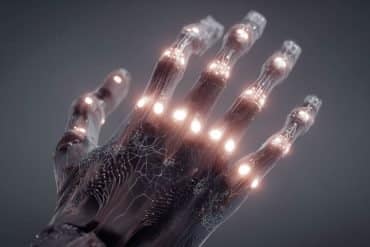Summary: New research shows that AI can identify complex regional pain syndrome (CRPS) with over 90% accuracy by analyzing gut microbiome patterns. Despite differences in geography and diet, a shared “microbiome signature” was detected across patients from Israel and Canada.
Even patients who no longer showed CRPS symptoms after limb amputation retained this microbiome pattern, suggesting it could reveal underlying susceptibility. These findings pave the way for microbiome-based diagnostics and may lead to earlier, more accurate detection of CRPS and other chronic pain conditions.
Key Facts:
- High Diagnostic Accuracy: AI identified CRPS through gut microbiome analysis with over 90% accuracy across countries.
- Persistent Microbiome Signature: Former CRPS patients retained gut microbiome patterns linked to the condition.
- Potential Susceptibility Marker: Findings suggest the microbiome may predispose certain individuals to develop CRPS.
Source: McGill University
McGill University researchers, in collaboration with colleagues in Israel and Ireland, have developed AI technology that can detect patterns in gut bacteria to identify complex regional pain syndrome (CRPS) with remarkable accuracy, potentially transforming how CRPS is diagnosed and treated.
CRPS, estimated to affect between 400,000 and 2.1 million people worldwide, typically develops in a limb after injury or surgery and can lead to long-term disability. It causes severe, persistent pain – often far worse than the initial injury – along with swelling and changes in skin colour and temperature.

“CRPS remains challenging to treat, with patients often experiencing prolonged suffering before receiving appropriate care,” said senior author Dr. Amir Minerbi, Director of the Institute for Pain Medicine at Rambam Health Campus in Haifa, Israel, and senior lecturer at the Technion – Israel Institute of Technology.
A ‘microbiome signature’ of CRPS
The study, published in the journal Anesthesiology, used advanced machine learning to analyze gut microbiome samples from two cohorts, one from Israel and one from Canada.
“What’s remarkable about this study is that we trained our machine learning algorithms on high-quality microbiome data from patients in Israel and successfully predicted CRPS in Canadian patients with over 90 percent accuracy,” said Emmanuel Gonzalez, lead author and member of the McGill Centre for Microbiome Research and Canadian Centre for Computational Genomics.
“This is extraordinary because factors like geography, climate, diet and natural variation between people typically create large microbiome differences. Yet, our AI approach seems to have identified a common ‘microbiome signature’ of CRPS, suggesting microbiome-based diagnostics could work across populations in different countries.”
The research identified significant differences between the gut bacteria of CRPS patients and pain-free individuals.
Findings suggest some people might be prone to CRPS
Surprisingly, the researchers also found that even patients whose symptoms completely disappeared after limb amputation still had the same gut bacteria pattern, or microbiome signature, linked to CRPS.
“This persistent signature suggests the gut microbiome might make some people more prone to developing CRPS, with an injury or other event triggering the condition,” said Dr. Yoram Shir, Professor in the Department of Anesthesia at McGill’s Faculty of Medicine and Health Sciences, who led the clinical work in Montreal.
The findings were based on analyses of 120 microbiome and over 100 plasma samples, making this one of the largest-ever investigations of the gut microbiome in connection with chronic pain conditions.
Funding: The study was funded by the Rambam Health Care Campus, the Weston Family Foundation, the Alan Edwards Pain Management Unit, McGill University Health Centre and the Rambam Institute for Pain Medicine.
About this AI, Microbiome, and pain research news
Author: Keila DePape
Source: McGill University
Contact: Keila DePape – McGill University
Image: The image is credited to Neuroscience News
Original Research: Closed access.
“Altered Gut Microbiome Composition and Function in Individuals with Complex Regional Pain Syndrome” by Amir Minerbi et al. Anesthesiology
Abstract
Altered Gut Microbiome Composition and Function in Individuals with Complex Regional Pain Syndrome
Background:
Complex regional pain syndrome is a chronic pain syndrome typically affecting a limb. It is characterized by severe spontaneous and evoked pain, along with vasomotor, autonomic, and motor signs and symptoms.
Although dysregulation in several physiologic systems has been suggested in complex regional pain syndrome (CRPS), including aberrant inflammatory and immune responses, vasomotor dysfunction, and nervous system changes, the pathophysiologic mechanisms underlying the syndrome remain elusive.
Effective treatment options are also limited. Previous research has highlighted the role of the gut microbiome in chronic pain, prompting us to investigate the composition and function of the gut microbiome in CRPS.
Methods:
The gut microbiomes of individuals with CRPS to age-, sex-, and ethnicity-matched pain-free control participants were compared using 16S rRNA gene amplification. To minimize environmental confounders, participants were recruited from two geographically independent regions.
To explore potential changes in gut bacteria–derived metabolites, targeted metabolomic analysis of feces and plasma was performed. Finally, machine learning algorithms were trained to identify the gut microbiome composition specific to CRPS patients and were tested on a validation cohort.
Results:
In this study, differential abundance analysis revealed significant differences in several bacterial taxa when comparing 53 CRPS patients to 52 unrelated controls, including alterations in short-chain fatty acid–metabolizing species.
Targeted stool and plasma metabolite analysis confirmed differences in fecal and plasma short-chain fatty acid levels between CRPS patients and controls. Notably, the microbiome composition alone allowed accurate classification of patients and controls in a geographically independent test cohort.
Conclusions:
These findings highlight unique compositional and functional changes in the gut microbiome of individuals with CRPS, thus contributing to the growing body of evidence supporting the role of the gut microbiome in chronic pain syndromes.
Furthermore, they pave the way for further studies elucidating the pathophysiology of CRPS and exploring new diagnostic aids and treatment modalities.






